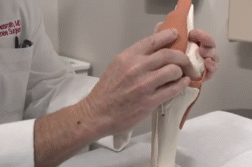ORLANDO, Fla. (Ivanhoe Newswire)— During some spinal procedures, doctors fuse vertebrae together to eliminate back pain. Precision is critical … just a few millimeters one way or the other could damage delicate nerves. Now, an orthopedic surgeon has developed a first-of-its-kind system that is improving accuracy and a patient’s time on the table. Martie Salt has moreabout spine surgery
During a traditional spinal procedure, surgeons focus on the patient in front of them—but also need to shift their eyes to monitors with critical patient information. Dr. Chetan Patel is a spinal surgeon with AdventHealth Neuroscience Institute in Orlando. He has designed a system called iSight.
“Basically, what we do is: I leave my traditional loops on, the magnification, and then all I have to do is put on my augmented reality glasses right on top of that. So essentially, it gives me a 55-inch screen, right in front of my eyes,” described Chetan K. Patel, MD, executive medical director for spine surgery at AdventHealth and section chair of robotics and navigation for the North American Spine Society (NASS).
All of the navigation and patient information Dr. Patel needs for surgery is on a smart device which is connected to the system. It’s then displayed in his field of vision, meaning he can see the patient and information in his glasses and does not need to look away—improving patient safety. And on average, Patel says the system reduces overall procedure time by at least ten minutes.
“In your normal everyday life, you think 10 minutes is not a big deal, but in the operating room, that’s a huge deal. Okay, 10 less minutes of anesthetic time, 10 less minutes of bleeding,” Dr. Patel explained.
An innovative solution improving results in the operating room.
AdventHealth’s internal review board approved the use of the iSight system, which Doctor Patel has used since May of 2020. In the patients he has treated to date, he says he has seen a 51 percent reduction in the time it takes to place surgical screws.
Contributors to this news report include: Cyndy McGrath, Executive Producer; Roque Correa, Videographer & Editor.
To receive a free weekly e-mail on Medical Breakthroughs from Ivanhoe, sign up at: http://www.ivanhoe.com/ftk
MEDICAL BREAKTHROUGHS
RESEARCH SUMMARY
TOPIC: AUGMENTED REALITY IMPROVES SPINE SURGERY WITH iSIGHT
REPORT: MB #4872
BACKGROUND: Virtual reality is the art and science of creating a virtual environment that provides a standardized, safe and flexible platform. Using virtual reality can allow for the assessment of various regions of the body for examination, diagnosis, planning and for the surgical training. In order to be able to use virtual reality for this purpose the user of this technology should be exposed to a realistic multidimensional visual stimulus which will allow the full integration of coherent, motor and mental functions of the operator. Based on the level of presence experienced by a user, virtual reality technology can be used for both immersive virtual reality and non-immersive virtual reality which offers the potential of combining the two for such things as integrating computer images on the real environment using semi-transparent glass.
(Source: https://bmcoralhealth.biomedcentral.com/articles/10.1186/s12903-019-0937-8)
DIAGNOSING: Using virtual reality in healthcare practices can be used to help with medical treatments by giving doctors the ability to view the inside of the human body virtually and allowing patients to see a virtual representation of their surgical plan by showing them a 360° VR reconstruction of their anatomy & pathology. Virtual reality in health care can also be used to help manage pain and physical treatments. Virtual reality for physical therapy has been shown to be effective in speeding up recovery time because giving patients the option to do their prescribed daily exercises in a virtual environment can make the activity more fun and as a result can keep the patient focused.
(Source: https://visualise.com/virtual-reality/virtual-reality-healthcare)
NEW TECHNOLOGY: The possibility of medical VR could allow clinical researchers and real-life medical practitioners. Although the field is relatively new, there are increasing examples of VR having a positive effect on patients’ lives and physicians’ work. The first VR surgery was conducted in 2016 which was available for real time viewing. Medical VR uses include being able to train aspiring surgeons and for surgeons to practice operations.
(Source: https://medicalfuturist.com/5-ways-medical-vr-is-changing-healthcare/)
FOR MORE INFORMATION ON THIS REPORT, PLEASE CONTACT:
SHERI PETERSON
SHERI.PETERSON@ADVENTHEALTH.COM
(407) 303-5452
If this story or any other Ivanhoe story has impacted your life or prompted you or someone you know to seek or change treatments, please let us know by contacting Marjorie Bekaert Thomas at mthomas@ivanhoe.com




